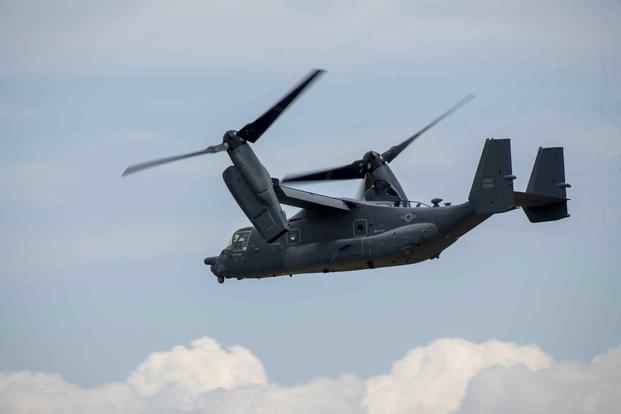
Air Force Special Operations Command said Wednesday that it’s just a matter of weeks before the service’s Osprey aircraft will again be deployed to combatant commanders across the globe following a grounding and safety checks triggered by a deadly crash last year.
Lt. Gen. Michael Conley, the head of the command, told reporters at an Air and Space Force Association conference outside of Washington, D.C., that he’s confident in the aircraft and that more than half of the fleet is already cleared to fly and ready to deploy. He said the entire fleet should be flying by early next year.
The news comes less than a year after a deadly November CV-22 Osprey crash in Japan that claimed the lives of eight airmen. The incident led to groundings across the three services that fly the tiltrotor aircraft and raised new concerns over mechanical issues with components in the Osprey’s gearbox.
Read Next: Soldiers Set to Get New Deployment Bonus as High Operations Tempos Strain the Army
“As of right now, we’re about 60% of the fleet that’s returned to flying. We’ve got about the same number of aircrew that are returned fully,” Conley said. “So, we will, along with our two overseas wings that have CV-22s that are almost back to full mission readiness, we will deploy out here in the coming weeks back to support other geographic commanders.”
Conley said that any restrictions on the aircraft imposed by the Osprey V-22 Joint Program Office will not deter how combatant commanders can utilize them. Naval Air Systems Command, or NAVAIR, which runs the Joint Program Office, has restricted the Ospreys from flying more than 30 minutes from a suitable landing spot, Military.com has previously reported.
He added that, every 10 days or so, the service is completing safety checks and clearing roughly three Ospreys for flight. Conley anticipates the entire 51 CV-22s in the fleet will be returned to service by late 2024 or early 2025.
The decision to start providing CV-22s to combatant commanders comes as families have lost airmen and Marines in recent years due to fatal Osprey crashes. Many are still grappling with grief and trying to make sense of the tragedies.
A family member of an airman who died in the Nov. 29 crash in Japan told Military.com that they were skeptical of the Air Force deploying Ospreys again and said the loved ones of aircrews should be prepared for the worst.
“Our hearts go out to the families of the next unlucky Osprey crew,” the family member said. “Words cannot do the experience justice, but know that the Osprey families are here for you.”
The Nov. 29 Air Force Special Operations Command crash of the CV-22 with the call sign Gundam 22 claimed the lives of Maj. Jeffrey Hoernemann; Maj. Eric Spendlove; Maj. Luke Unrath; Capt. Terrell Brayman; Tech. Sgt. Zachary Lavoy; Staff Sgt. Jake Turnage; Senior Airman Brian Johnson; and Staff Sgt. Jake Galliher.
Military.com reported — after obtaining internal safety documents examining the Nov. 29 crash — that a mechanical issue that caused the incident had been identified as far back as 2013 and a warning was sent to the Pentagon, but the concerns went unresolved. The cause of the Japan crash was determined to be the fracturing of a high-speed planetary pinion gear in the aircraft’s prop rotor gearbox.
Despite the earlier concerns brought up in the crash report, Conley told reporters that he did not believe there were any concerns from a manufacturing standpoint with Bell-Boeing, the joint venture between the two companies that makes the aircraft.
Additionally, Vice Adm. Carl Chebi, who heads NAVAIR, told Congress in June that he did not expect the fleet to be fully operational until mid-2025. But Conley said his Ospreys will be ready to go sooner than that.
“So, there’s certainly nothing foolproof, but we’ve learned a lot during the investigation and both Bell and NAVAIR, in their own relations, have learned a lot, and we’re taking what we’ve learned to try to prevent this from happening again,” Conley said.
Prior Air Force policy says that after three “chip burn” lights — an indicator that the gears are shedding metal — Osprey crews should “land as soon as practical,” which is the first and least serious of three landing conditions. But the policy also gives pilots the opportunity to press on.
The Gundam 22 crew did press on after the chip burn lights and did not violate their training. Following the crash, AFSOC changed its policies, and crews are now advised to land as soon as practical after a single chip burn and “as soon as possible” following a second chip burn.
Amber Sax, the wife of Capt. John Sax, a pilot who died on a Marine Corps Osprey when it crashed into the southern California desert on June 8, 2022, told Military.com she still doesn’t believe there are enough public-facing solutions to the mechanical problems that have plagued the aircraft.
“The fear many surviving family members continue to have is that the failures that caused the loss of their loved one have not been fully addressed and corrected. We each have a list of friends, some we consider family, who continue to fly in the Osprey,” Sax said. “The thought of 20 or more, given the number of lives an Osprey can carry, haunts many of us daily. We need to know it’s been fixed and it won’t happen again.”
Conley reiterated his confidence in the steps AFSOC had taken to address the issues and said, in regard to the Gundam 22 crash, that “the data suggests it’s very rare.”
“To be blunt about it, I would not put the men and women of AFSOC back in the plane if I wasn’t confident that it could do what we needed to do,” Conley added.
— Konstantin Toropin contributed to this report.
Related: Flaw in Osprey Gears Was Known a Decade Prior to Deadly Japan Crash, Internal Report Shows






